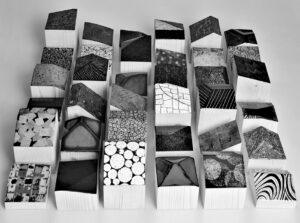Panel Discussion

4 Honorable Mentions(1/2)
TAMAYA(MC) ───── Thank you. Next, we would like Mr KAWAKAMI to make comments on “Fountain Pens” by Yuko HIROSAWA.

奨励賞
変わり塗り万年筆
Fountain Pens
W15.3 × D1.7 × H1.7(各)
2023
広沢 有子
HIROSAWA, Yuko (Japan)
KAWAKAMI ───── Ms HIROSAWA – congratulations on your Honorable Mention. I’m always attracted by thick fountain pens. This type of fountain pen decorated with maki-e or takamaki-e, with a rather precise and careful finish, has been produced for a long time in Japan. I have thinner fountain pens but they seem too precious and only to be used for special occasions. Because of that, I tend to put the slender decorated fountain pens into a drawer without ever using them. However, these thicker pens with their powerful patterns make us feel at ease. Although the creator uses a variety of techniques and materials such as rankaku (eggshell) and gold leaf, these pens have a casual feel, perfect for everyday use. The creator is from Niigata Prefecture, where various kawari-nuri (coating style) techniques have been handed down, and she makes the best use of the traditional techniques. The sturdiness of the fountain pens is quite powerful and I would like one for myself.
I wasn’t able to write with the pen, but personally, I thought it would be nice if there was an old-fashioned pump system instead of the dropper. I like fountain pens with a soft nib which allows me to write from beginning to end.
If you look closely at the fountain pens, it looks like she used ebonite as a material. I think the finishing technique of where the lid and the body connect needs to be a little more precise. I don’t know if it was done like that for a casual effect, but I think it needs a more delicate feeling for that part. With a little more refinement, the result will be a charming product that is easier to use and to use with care. I think the product will be perfect after the finishing touches, and I would like to purchase one for myself. Is the creator present here at the venue today?
At the previous exhibition, she submitted a pill case and also received an Honorable Mention. The base of the work was molded metal with screws. I felt then that the metal and urushi parts were off-balance. I think that she still needs improvement with the refinement of her works, but I must congratulate her again.
TAMAYA(MC) ───── Thank you. Next, we would like Ms YAMADA to make some comments on the Honorable Mention winner “36 souls” by Miraia ESTOPÀ SANCHO from Spain.

奨励賞
36 Souls
W42 × D42 × H8.5
2023
ESTOPÀ SANCHO, Mireia (Spain)
YAMADA ───── As soon as I saw this set, I wanted to buy it for my grandchildren. I felt that it is the essence of Spain represented in a beautiful design. When my grandchildren come to my house, the first thing they want to do is draw or make something. This is because there are so many tools lying around the place. With a fun world like this at home, I’m sure that children today would be able to create wonderful things. If you encourage young children at an early age to be open to such sensitivity of beauty this way, it gives marvelous results. I assume that the wooden bases are made from leftovers of the studio and I’m happy that they could put it to good use.
Is the artist here today? I would like to ask her what her thought process was for making this particular work. At the Final Assessment, I really enjoyed evaluating the works as a juror. It was a big responsibility to judge for such an important exhibition so I think it’s our duty to understand the artists’ ideas and thoughts and to introduce them to all those who love lacquer, as well as to young urushi artists to encourage them to participate in the future.
If children can experience the beauty of lacquer from a young age, their senses will be expanded. I would like children to experience creativity, not by playing with plastic objects, but by interacting with natural materials. I like the use of the wooden leftovers, and I hope that more sets of lacquer-coated wooden blocks can be produced for sale.
Each block has one face coated and decorated with various patterns. Each pattern is beautiful and emblematic of Spain. Following this concept, Japanese kimono komon patterns can be developed as a motif. I enjoyed imagining all the various possibilities during the Final Assessment. This is a good example of how the International Urushi Exhibition itself can be enjoyed.
Although these patterns are associated with clothing, they could be applied to Japanese rice bowls, tea bowls or tiered boxes. This is the joy of being a juror that opens our eyes to new possibilities for the world of lacquer. I would like to express my gratitude for this experience and I hope that urushi artists will continue to expand the future of lacquer.
